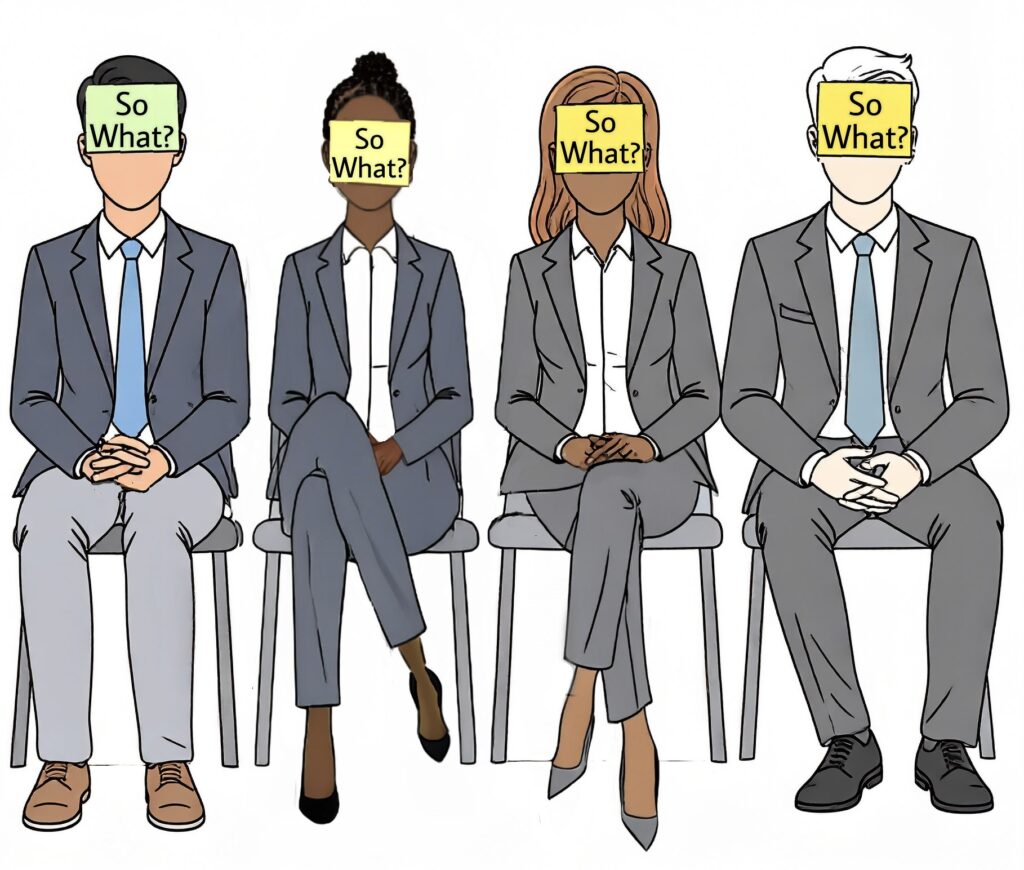To Start: Get Still and Focused
What does “ready” look like? Football players lined up at the line of scrimmage. Runners crouched on their starting blocks. Dancers poised in the wings. A conductor with arms raised before the downbeat. It is completely still, before the flurry of movement (or words). Take that moment. And take a deep breath.
Why Should They Listen?
Sorry, but attention spans are short, audiences are “otherwise engaged” and there’s lots of free-floating anxiety around. Bottom line when you present: everyone in your audience is basically looking at you and thinking: So what? Why should I care?
Give Them The Why
Tell them right up front. What’s in it for them? Be warm, friendly and relevant. Help them see you value their time and give them an easy entry point into your content.
Avoid Preamble
Preamble is everything we say before we say what we actually want to say. Nobody needs it! Don’t dilly-dally around. Dive right in and say something honest, true and meaningful.
Start With A Hook
“Thanks for having me.” was the opening line for pretty much every presentation at a company where I did extensive communications coaching. Certainly companies all have protocols, and you don’t want to stick out like a sore thumb, but I always felt that opening was a waste. Send a very different message with:
Thanks for this opportunity to explain the…
I appreciate that we’re all here so we can discuss…
I’m grateful for this time today to review the results of…
Meet Your Audience Where They Are
before you take them where you want them to go. Use your opening to build some emotional alignment (how’s everyone feeling) and contextual alignment (we’re all in this together). What you actually say can be less important than the effort of acknowledging them and trying to connect.
Before-I-Begin Questions
If you’re uncertain of the tone in the room or on the screen, ask. You can gather helpful intelligence by using the phrase, “Before I begin…” No one’s defensive yet (because you haven’t “started”). This is a quick way to help you tweak your content to meet new audience needs.
Before I begin, has anything changed since we scheduled this meeting last week?
Before I begin, is everyone still good for the full hour?
Before I begin, have we heard back from accounting?
Name That Elephant
If it’s obvious, call it out and name it. What’s going on? What’s just happened? What are people thinking, but not saying? This helps create a sense of camaraderie.
Who’s Driving This Bus?
When my kids were young and we were at the tail end of a road trip, there would be plenty of whining and nudgy behavior. One time, out of total exasperation, I made up the “We’re almost home…” song which I sang at the top of my lungs for the last half-hour. It quieted them down and became a staple of every trip thereafter.
Audiences want to know (and they want to trust the driver). What’s the roadmap? Where are we going? When are we going to get there? Tell them.
No Apologies
Real life means you may not be as prepared as you would wish. I’m a believer that we don’t need to share the negatives; just go with whatever positives you can muster. You do NOT need to say:
X Unfortunately, I wasn’t able to…
X If we had more time, I could…
X I apologize if you’ve already heard this, but…
X I’m not usually asked to talk about…
“The Scariest Moment Is Always Just Before You Start”
This quote is from Stephen King, the murder mystery horror writer. Now, if anyone knows scary, it’s Stephen King! So feel the fear and do it anyhow. You are not alone; I have confidence in you; you can do this.
Ready? Set? Go for it…You’re On!
Be the happy recipient of more great tips and techniques, along with intelligent musings on the state of communications, by signing up for Diane Ripstein’s regular NewsNotes right here.
